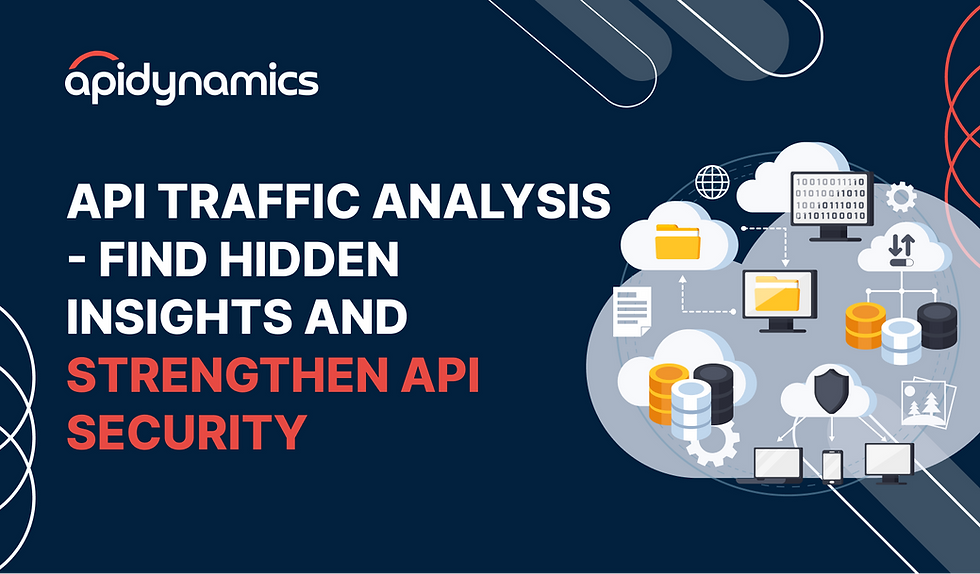Strengthening API Security with Risk-Based Adaptive Authentication: The Role of APIDynamics
- APIDynamics
- Aug 27, 2023
- 3 min read
Updated: Nov 25, 2024

In an era where APIs drive the interconnected digital world, ensuring robust security for API authentication is a top priority. Traditional authentication methods have proven inadequate in defending against advanced threats, prompting the need for a more dynamic and context-aware approach. Risk-Based Adaptive Authentication, when coupled with the innovative capabilities of APIDynamics, emerges as a formidable solution to fortify API security.
The Shifting Landscape of API Security APIs, or Application Programming Interfaces, have become the lifeblood of modern digital applications. They facilitate the exchange of data and services between different software components, underpinning the functionality of countless apps and systems. With this growing reliance on APIs, safeguarding them against unauthorized access and potential breaches is paramount.
Historically, API security primarily relied on static credentials like API keys or tokens. While these mechanisms offered a basic level of protection, they faltered in the face of evolving cyber threats. Credential stuffing attacks, token theft, and misuse exposed the limitations of traditional API security.
The Limitations of Conventional API Security
Credential Stuffing Vulnerabilities: In credential stuffing attacks, malicious actors leverage stolen username and password combinations to gain unauthorized access to user accounts and APIs. The widespread reuse of passwords across services amplifies the success of such attacks.
API Token Weaknesses: Static API tokens, once compromised, provide a window of opportunity for attackers to exploit the API until tokens are revoked or regenerated. This poses significant security risks.
Lack of Contextual Awareness: Traditional authentication methods lack contextual understanding. They rely solely on what the user knows (password) or what the user possesses (token), making it challenging to differentiate legitimate users from potential threats based on real-time context.
The Power of Risk-Based Adaptive Authentication
Risk-Based Adaptive Authentication represents a paradigm shift in API security. It introduces dynamic and context-aware authentication mechanisms, addressing the limitations of traditional approaches. Here's how it operates:
Real-Time Risk Assessment: Instead of static credentials, Risk-Based Adaptive Authentication continuously assesses the risk associated with each API request. It evaluates contextual factors such as user behavior, device information, geographic location, and more.
Contextual Decision Making: In response to the risk assessment, the system makes real-time contextual decisions. For example, if a user typically logs in from New York but suddenly attempts access from an unfamiliar location, the system may prompt them for additional authentication.
Multi-Factor Authentication (MFA): Risk-Based Adaptive Authentication can trigger MFA for API authentication when it detects high-risk scenarios or unusual behavior. MFA adds an extra layer of security, preventing unauthorized access even if credentials are compromised.
Anomaly Detection: The system continuously monitors user behavior and API traffic patterns, swiftly detecting anomalies like unexpected spikes in traffic or irregular data access. These anomalies are flagged as potential threats.
Customizable Policies: Organizations have the flexibility to define and fine-tune authentication policies to align with their specific needs. This customization empowers organizations to strike the right balance between security and user experience.
Leveraging APIDynamics for Enhanced API Security
APIDynamics takes the principles of Risk-Based Adaptive Authentication to the next level, offering a comprehensive solution for API security. It seamlessly integrates with existing systems and offers several advantages:
Enhanced Security: By continuously assessing risk and adapting authentication, APIDynamics provides robust protection against unauthorized access and potential data breaches.
Improved Non-Interactive Experience: APIDynamics minimizes disruption, prompting additional authentication to B2B APIs only when risk factors warrant it. This ensures a smoother and less intrusive experience for non interactive API authentication.
Cost Savings: Preventing unauthorized access and potential data breaches saves organizations from the financial burdens associated with security incidents and regulatory penalties.
Compliance: APIDynamics aligns with various compliance requirements, ensuring organizations meet essential security standards and regulations.
In conclusion, as APIs continue to be the backbone of modern digital ecosystems, securing them against evolving threats is a critical imperative. Risk-Based Adaptive Authentication, when augmented by the capabilities of APIDynamics, offers a proactive and context-aware approach to API security. Organizations can fortify their APIs, protect sensitive data, and safeguard their digital assets effectively by embracing this advanced authentication methodology.




Comments